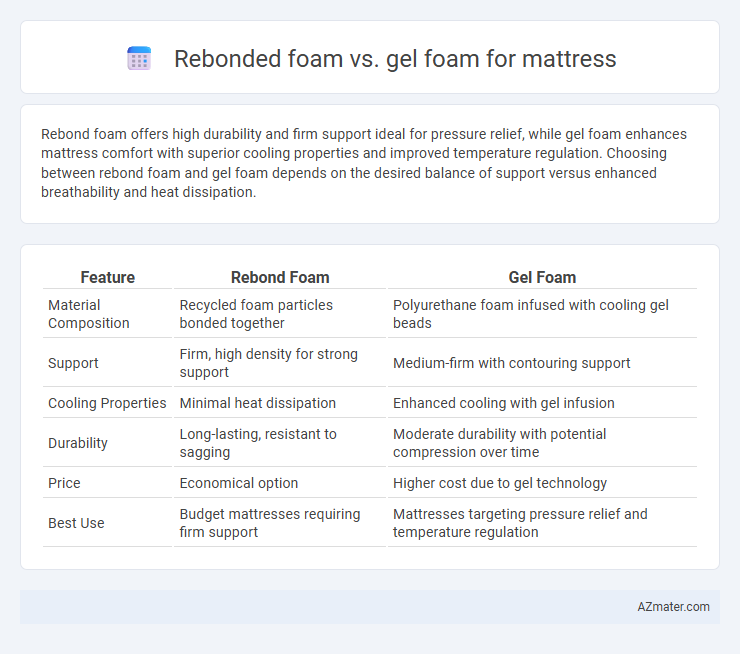Rebond foam offers high durability and firm support ideal for pressure relief, while gel foam enhances mattress comfort with superior cooling properties and improved temperature regulation. Choosing between rebond foam and gel foam depends on the desired balance of support versus enhanced breathability and heat dissipation.
Table of Comparison
| Feature | Rebond Foam | Gel Foam |
|---|---|---|
| Material Composition | Recycled foam particles bonded together | Polyurethane foam infused with cooling gel beads |
| Support | Firm, high density for strong support | Medium-firm with contouring support |
| Cooling Properties | Minimal heat dissipation | Enhanced cooling with gel infusion |
| Durability | Long-lasting, resistant to sagging | Moderate durability with potential compression over time |
| Price | Economical option | Higher cost due to gel technology |
| Best Use | Budget mattresses requiring firm support | Mattresses targeting pressure relief and temperature regulation |
Understanding Rebond Foam: Features and Benefits
Rebond foam, made from recycled foam scraps bonded together, provides exceptional durability and firm support, making it ideal for mattress bases. Its high density ensures excellent weight distribution and pressure relief, enhancing overall comfort and longevity. Rebond foam's breathability and resilience contribute to a cooler sleep experience and resistance to sagging compared to standard foams.
What is Gel Foam? Key Characteristics
Gel foam in mattresses integrates polymer gel particles within memory foam to enhance cooling and comfort. Key characteristics include excellent temperature regulation, pressure relief, and improved durability compared to traditional foams. It offers superior breathability and minimizes heat retention, making it ideal for hot sleepers seeking a cooler sleep experience.
Comfort and Support: Rebond vs Gel Foam
Rebond foam offers firm support by combining shredded foam pieces into a dense, resilient base that maintains its shape under pressure, ideal for individuals seeking durable and consistent support. Gel foam integrates cooling gel beads or swirls within memory foam, enhancing pressure relief and airflow to provide a cooler, contouring comfort that adapts to body shape. While rebond foam excels in structural support and longevity, gel foam prioritizes temperature regulation and adaptive cushioning for improved sleep comfort.
Durability Comparison: Which Lasts Longer?
Rebond foam, crafted from shredded foam pieces fused together, offers exceptional durability due to its dense and resilient structure, often lasting 7-10 years under regular use. Gel foam incorporates cooling gel beads within memory foam, providing enhanced temperature regulation but tends to have a shorter lifespan of around 5-7 years because of its softer, more compressible composition. When comparing durability, rebond foam generally outlasts gel foam, making it a preferred choice for mattresses requiring long-term support and resilience.
Temperature Regulation: Gel Foam vs Rebond Foam
Gel foam mattresses excel in temperature regulation due to their ability to disperse heat through embedded gel beads, maintaining a cooler sleep surface compared to rebond foam. Rebond foam, composed of shredded foam particles bonded together, tends to retain heat and offers less breathability, which might lead to warmer sleeping conditions. Choosing gel foam is ideal for individuals who prioritize a cooler and more temperature-neutral sleep environment.
Motion Isolation: Which Mattress Reduces Disturbance?
Rebond foam offers moderate motion isolation by absorbing movements but tends to be denser and less responsive, which can transfer some motion across the surface. Gel foam excels in motion isolation due to its viscoelastic properties combined with gel infusion, effectively dampening movement and minimizing disturbance between sleepers. Mattresses with gel foam layers consistently outperform rebond foam in reducing motion transfer, making them ideal for light sleepers sharing a bed.
Health and Allergies: Safe Choices for Sensitive Sleepers
Rebond foam is made from shredded scrap foam bonded together, which may contain adhesives and chemicals that can trigger allergies or respiratory issues for sensitive sleepers. Gel foam, infused with gel particles, offers better breathability and antimicrobial properties, reducing the risk of allergens such as dust mites and mold. Choosing gel foam mattresses can promote healthier sleep environments by minimizing allergen exposure and enhancing air circulation.
Price and Value: Cost Differences Explained
Rebond foam mattresses are generally more affordable than gel foam options due to lower manufacturing costs and the use of recycled foam materials. Gel foam mattresses, infused with cooling gel beads, tend to be pricier but offer enhanced temperature regulation and comfort. Choosing between rebond foam and gel foam involves balancing initial investment with long-term value based on comfort needs and budget constraints.
Ideal Sleepers: Who Should Choose Rebond or Gel Foam?
Rebond foam suits budget-conscious sleepers seeking firm support and durability, often preferred by back and stomach sleepers due to its resilient and dense structure. Gel foam is ideal for hot sleepers and side sleepers because of its superior cooling properties and pressure relief, contouring closely to the body to reduce pain in shoulders and hips. Choosing between rebond and gel foam depends on individual sleep positions, temperature preferences, and desired mattress firmness for personalized comfort.
Final Verdict: Choosing the Right Foam for Your Mattress
Rebond foam offers high durability and firm support, making it ideal for heavy sleepers and budget-conscious buyers seeking long-lasting mattresses. Gel foam provides superior pressure relief and temperature regulation, perfect for those who prioritize comfort and a cooler sleep environment. Selecting the right foam depends on your sleeping style, body weight, and preference for support versus cushioning in mattress performance.

Infographic: Rebond foam vs Gel foam for Mattress
 azmater.com
azmater.com